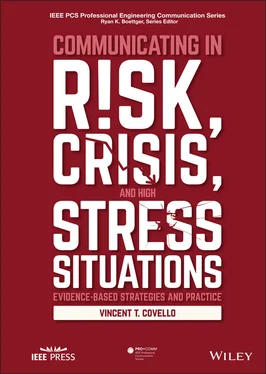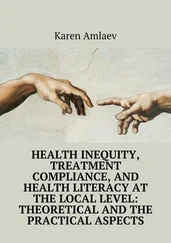Unfortunately, the article also reported an internal poll of managers and engineers at the facility, asking how they would like to spend the facility’s end‐of‐year funding surplus. Respondents had two primary choices:
1 repair the hairline crack and stop the leak of radioactive water, or
2 support work enhancements, including refreshments for the facility’s visiting speaker program.
The facility’s employees – applying their scientific knowledge and logic that the hairline crack was inconsequential – chose the refreshments.
I was hired to consult after the publication of this newspaper article. The engineers and managers explained to me, in meticulous technical detail, the nature of the crack and why the amount of radioactive water leaking into the community’s aquifer was miniscule and posed no threat to human health.
After I sat and listened to a variety of technical presentations, I conducted a training on basic principles of risk, high concern, and crisis communication. I agreed that accurate technical facts were essential for decision‐making, but facts by themselves were not always sufficient. Technical facts are only one factor that influences public fears and risk perceptions. Emotional factors also drive decision‐making. Trust is based on attributes, including caring and concern. People in high‐stress situations need to know you care before they will listen to you. I pointed out that nuclear power and radiation is a highly emotionally charged issue and raises high levels of anxiety for the public.
I predicted the public would perceive the facility’s actions as a major breach of trust, notwithstanding the actual lack of potential harm. I recommended actions the managers and engineers could still take to regain trust and counter community anger and outrage. These recommendations included a sincere apology for not communicating early and a commitment to restore trust and ensure the mistakes would not be repeated. Such actions included environmental restoration and creation of a community advisory committee with significant oversight powers.
Unfortunately, I was brought into this situation too late. An avalanche of negative stories followed the first newspaper article, triggering community outrage before leadership could implement any of the recommended actions. Outrage was further fueled by the publication of a previously unrevealed government report that cataloged a long history of environmental shortcomings at this facility. That report cited the facility for failing to respond to the discovery of a leak of radioactive water over 10 years earlier and described delays on promises to make environmental improvements.
Government agencies withdrew their support for continued operation of the reactor, citing environmental and economic concerns. Community and environmental groups pressured government representatives to deny the reactor a permit to continue to operate. The nuclear reactor was indefinitely closed, and all the scientific research it supported ended.
I began Chapter 1 with this story because it encapsulates several vital lessons:
First, effective communication is critical to the effective prevention of and response to risks, high concern issues, and crises.
Second, trust is a prerequisite for communicating successfully about controversial and emotionally charged issues.
Third, organizations and institutions interact with their environments, eco‐systems, and communities. Those responsible for leading those organizations and managing them at every level must understand how stakeholders view what they do; they must seek and be prepared for stakeholder engagement, and they must build – and earn – and nurture trust from those interested or affected.
Fourth, leaders, managers, supervisors, and technical professionals require training in the principles of trust, stakeholder perceptions, and communication about risks, high concerns, and crises prior to encountering situations that require effective communication.
If the facility managers and engineers in this story had learned and applied the principles and values discussed in the chapters to follow, the research reactor would likely be in operation today.
1.2 What Will Readers Find in This Book?
This book identifies the principles underlying effective communication in situations where there is risk, crisis, or other causes of high concern. This book describes both the differences between and similarities among the situations of risk, crisis, and high concern, describing principles that underlie all such situations and practices specific to each. Previous books have written about these topics, but there are now important new fields of scientific inquiry and enormous new challenges in the communication environment. Inquiries are taking place on diverse fronts, including scientists and experts in anthropology, economics, engineering, epidemiology, law, psychology, sociology, media studies, medicine, statistics, toxicology, and neuroscience. Each discipline has generated publications related to risk, high concern, and crisis communication, and each adds to the understanding of the practice. However, with few exceptions, nearly all existing resources focus on a specific subset of the literature, on a specific area (e.g. bioterrorism, nuclear power, climate change, or genetically modified foods), or on topics of direct interest to the authors’ discipline. As a result, the literature has become highly specialized and dispersed.
While this literature specialization serves experts within specific disciplines, it is less useful for the many professionals who work outside of these explicit fields and who may encounter any one of a wide range of challenges. This book offers a common framework of the major principles, strategies, and tools and shows how they relate to inform the work of communicators in high concern or emotionally charged situations.
This book provides the background and practices essential for successful communication in risk, high concern, and crisis situations. It describes what often happens when feelings and facts collide. It explains why leadership accepts some ideas for managing a risk, high concern, or crisis issue and rejects others.
Why do some projects that encounter high concern and controversy go forward and others do not? Why are some facts, information, and guidance recommended to stakeholders in high concern situations heeded more than others? Why are some presentations about high concern issues well received, while other presentations are ignored or incite anger? Why do some team interactions proceed without a hitch and others fail? Why are some interactions with upper management effective and others are ignored? Why are some people trusted with challenging communication responsibilities and others are not? Why do some meetings about high concern issues succeed while others fail? Why are some people better able to handle difficult or controversial situations than others?
This book addresses and answers these questions. The answers often come down to knowledge of risk communication principles and practices.
1.3 Why You Will Use This Book
I organized this book around two primary aims. The first is to help professionals understand the best communication practices for a high concern or emotionally charged situation. My second goal is to give readers the skills to apply these best practices in a variety of situations.
How you communicate in high concern situations will directly influence the course of the events you manage. In a crisis, stakeholders (i.e. interested and affected individuals and organizations) demand timely and accurate information. Leaders, managers, engineers, scientists, and technical professionals will be asked to take on unfamiliar roles and responsibilities. Those involved in the crisis will be surrounded by uncertainty, ambiguous information, high emotion, and upset people. Beyond the situation of an immediate crisis, competence in risk, high concern, and crisis communication is a prerequisite for navigating through the many situations where feelings and facts are at odds, whether it is concern about a health‐threatening risk or high anxiety about an impending change. Performed well, high concern communication can enhance trust and confidence, calm nerves, reduce anxiety, encourage cooperative behaviors, provide information for informed decision‐making, and help mitigate or reduce potential adverse outcomes. Poor, inadequate high concern communication can disrupt processes, fan emotions, undermine trust and confidence, and result in adverse outcomes.
Читать дальше












